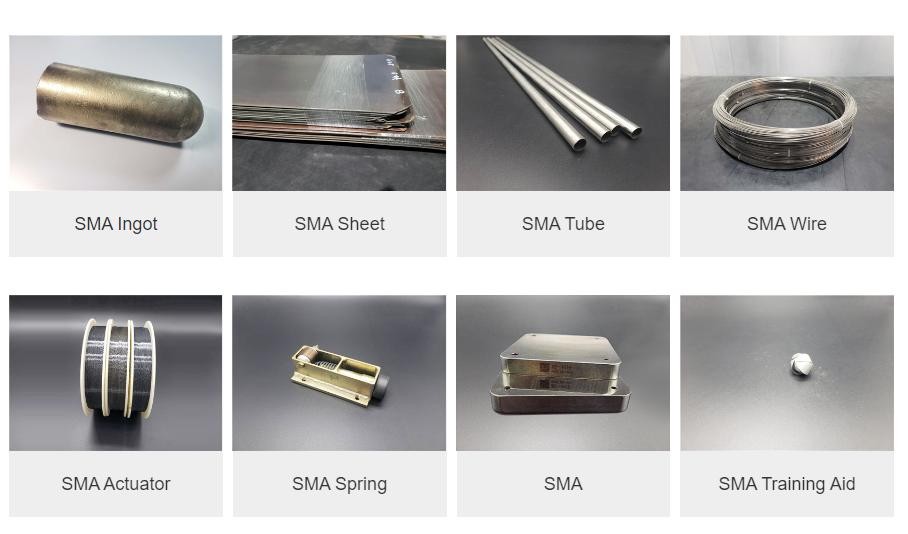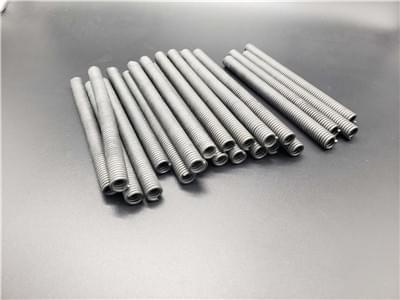Introduction

In the realm of modern engineering, standards play a crucial role in ensuring quality and consistency across various materials and products. One such standard is ASTM F2063, which specifically addresses the requirements for wrought nickel-titanium alloys. Understanding the significance of this standard not only enhances product reliability but also fosters innovation in industries that rely on these advanced materials.
The Importance of ASTM F2063
ASTM F2063 serves as a benchmark for manufacturers and engineers working with nitinol, a unique alloy known for its remarkable shape memory and superelastic properties. By adhering to the F2063 Standard Specification for Wrought Nickel-Titanium, companies can ensure that their products meet rigorous safety and performance criteria. This standard is particularly vital in sectors such as medical devices, aerospace engineering, and consumer goods where precision and reliability are non-negotiable.
What is ASTM F2063 in a Nutshell?
So, what is ASTM F2063? At its core, it outlines specifications related to the composition, mechanical properties, and testing methods applicable to wrought nickel-titanium alloys. This includes guidelines on how to evaluate critical aspects like shape memory behavior and superelasticity—both of which are essential for applications ranging from stents to flexible actuators.
Why Nitinol Matters in Modern Engineering
Nitinol stands out in modern engineering due to its extraordinary capabilities that surpass those of traditional metals. Its ability to return to a predetermined shape after deformation makes it invaluable in various applications where flexibility and strength are paramount. As we delve deeper into the intricacies of ASTM F2063 Shape Memory and Superelastic Nitinol Strip, it becomes clear why this alloy continues to be at the forefront of technological advancements across multiple industries.
Overview of ASTM F2063

The ASTM F2063 standard is a pivotal guideline that governs the specifications for wrought nickel-titanium, commonly known as nitinol. This standard serves as a cornerstone for manufacturers and engineers aiming to harness the unique properties of nitinol in various applications. Understanding what ASTM F2063 encompasses is crucial for ensuring quality and performance in products made from this innovative material.
Defining the F2063 Standard Specification
The F2063 Standard Specification for Wrought Nickel-Titanium outlines essential criteria regarding the composition, mechanical properties, and processing methods for nitinol materials. This specification not only defines acceptable limits but also provides testing methodologies to ensure consistency across production batches. By adhering to what is ASTM F2063?, manufacturers can guarantee that their nitinol products meet industry standards and customer expectations.
Key Features of Wrought Nickel-Titanium
Wrought nickel-titanium possesses remarkable characteristics that set it apart from conventional alloys. Notably, its shape memory effect allows it to return to a predetermined shape when heated above a specific temperature, while its superelastic behavior enables it to undergo significant deformation without permanent change. These features are encapsulated in the ASTM F2063 Shape Memory and Superelastic Nitinol Strip, making this alloy invaluable across multiple sectors.
The Role of GEE SMA in Nitinol Production
GEE SMA plays a critical role in the production of nitinol by adhering strictly to the guidelines set forth by ASTM standards, including what is the ASTM standard for nitinol? Their expertise ensures that every batch of wrought nickel-titanium not only meets but often exceeds these specifications. By focusing on quality control and innovation, GEE SMA contributes significantly to advancements in melt flow index testing and air permeability ASTM standards, further enhancing the reliability of their nitinol products.
Understanding Nitinol Properties

Nitinol, a remarkable alloy of nickel and titanium, boasts unique properties that set it apart from traditional materials. Central to its appeal are the shape memory effects and superelastic behavior that make it invaluable in various applications. The F2063 Standard Specification for Wrought Nickel-Titanium provides a framework for understanding these properties and their implications in engineering.
Shape Memory Effects Explained
The shape memory effect is one of Nitinol's most fascinating characteristics, allowing it to remember a predetermined shape after deformation. When heated above a specific temperature, known as the transformation temperature, Nitinol returns to its original form—an effect defined by the ASTM F2063 standard. This property has significant implications in fields such as medical devices, where implants can be inserted in a compact form and then expand once inside the body.
In practical applications, this means that surgical instruments can be made smaller for minimally invasive procedures while still providing robust functionality once deployed. The ability to revert back to an original shape makes Nitinol particularly useful in stents and guidewires used in cardiovascular surgeries. Overall, understanding this shape memory phenomenon is crucial when discussing what is ASTM F2063? and how it governs the use of Nitinol.
Superelastic Behavior and Its Applications
Superelasticity is another remarkable trait of Nitinol that allows it to undergo significant deformation without permanent change when subjected to stress within certain temperature ranges. This behavior occurs at temperatures above the transformation threshold but below the melting point, making it incredibly versatile for various applications outlined in the ASTM F2063 standard specification for wrought nickel-titanium.
The superelastic nature of Nitinol means that components can absorb shocks or impacts without fracturing or losing functionality—a vital feature in aerospace engineering innovations where reliability under stress is paramount. Additionally, this property finds its way into consumer products ranging from eyeglass frames to orthopedic devices that require resilience without compromising comfort or performance.
Comparing Nitinol to Other Alloys
When comparing Nitinol with other metal alloys, its unique combination of shape memory effects and superelastic behavior stands out significantly against traditional materials like stainless steel or aluminum. While these conventional alloys offer strength and durability, they lack the ability to return to an original shape or endure extensive deformations without yielding—features highly prized in modern engineering contexts governed by standards such as ASTM F2063.
Moreover, when discussing what is the ASTM standard for nitinol? it's essential to recognize how these specifications ensure uniformity across various applications involving different alloys while emphasizing performance metrics like fatigue resistance and corrosion resistance that are critical for long-term use. In contrast with other metals used widely today—Nitinol's adaptability opens doors for innovations previously deemed impossible.
Applications of ASTM F2063

The versatility of ASTM F2063, or the F2063 Standard Specification for Wrought Nickel-Titanium, is evident across various industries. This standard not only ensures the quality and consistency of nitinol but also highlights its unique properties that make it an ideal choice for innovative applications. From medical devices to aerospace engineering and even consumer products, the implications of this standard are far-reaching.
Medical Devices and Implants
In the realm of healthcare, ASTM F2063 has revolutionized the design and functionality of medical devices and implants. Nitinol's shape memory effect, as defined in the ASTM F2063 Shape Memory and Superelastic Nitinol Strip specifications, enables devices like stents to expand precisely within blood vessels at body temperature. Additionally, its superelastic behavior allows for flexible surgical tools that can navigate complex anatomy without causing damage.
The use of nitinol in orthodontic archwires is another prime example where ASTM standards come into play. These wires can return to their original shape after being bent or twisted, thanks to their unique properties outlined in the standard. As a result, orthodontists can provide effective treatments with less discomfort for patients while adhering to stringent safety regulations.
Aerospace Engineering Innovations
Aerospace engineering has also embraced ASTM F2063 due to nitinol's lightweight yet robust characteristics. The aerospace industry often seeks materials that can withstand extreme conditions while maintaining structural integrity; nitinol fits this bill perfectly. Components made from nitinol can adapt under varying temperatures without compromising performance, making them ideal for applications such as actuators in aircraft systems.
Moreover, engineers utilize the superelastic properties of nitinol in designing mechanisms that require flexibility and strength simultaneously—think landing gear components or deployable structures on spacecrafts! The ability to revert to a predetermined shape after deformation is crucial for ensuring reliability during critical flight operations while adhering to what is the ASTM standard for nitinol.
Consumer Products Utilizing Nitinol
Nitinol's remarkable features have trickled down into consumer products as well—who knew materials science could be so exciting? Everyday items like eyeglass frames made from nitinol showcase how this alloy’s shape memory capabilities allow them to bend without breaking, returning seamlessly to their original form when released—a testament to what is the air permeability ASTM standard ensuring quality control during production.
Furthermore, manufacturers are increasingly incorporating nitinol into gadgets such as self-heating coffee mugs or advanced sports equipment due to its lightweight nature paired with durability. With more companies exploring innovative uses guided by standards like ASTM F2063, we are likely just scratching the surface of what’s possible with this extraordinary material.
Key Testing Standards in Nitinol Production

The production of nitinol, particularly under the ASTM F2063 standard, is governed by various testing standards that ensure quality and performance. These standards are crucial for manufacturers aiming to produce reliable and effective nickel-titanium alloys. Understanding these key testing measures is essential for anyone involved in the nitinol industry.
What is the ASTM standard for nitinol?
The ASTM standard for nitinol is primarily encapsulated in the F2063 Standard Specification for Wrought Nickel-Titanium. This specification outlines the requirements for materials used in applications where shape memory and superelastic properties are critical. By adhering to this standard, manufacturers can ensure that their products meet industry benchmarks for performance and safety, making it a cornerstone of what is ASTM F2063?
Importance of Melt Flow Index Testing
Melt flow index testing plays a pivotal role in assessing the processability of nitinol materials produced under the ASTM F2063 guidelines. This test measures how easily a material flows when melted, which directly impacts its manufacturability and application versatility. In essence, understanding what is the ASTM standard for melt flow index can help engineers predict how well a specific alloy will perform during fabrication processes.
Air Permeability ASTM Standard Explained
Air permeability testing is another significant aspect of quality assurance within the framework of ASTM F2063. This standard evaluates how well gases can pass through a material, which can be crucial in applications such as medical devices where breathability may affect functionality or comfort. Knowing what is the air permeability ASTM standard allows manufacturers to optimize their products while maintaining compliance with industry regulations.
Future of ASTM F2063

The future of ASTM F2063 looks promising, with advancements in Nitinol technologies paving the way for innovative applications across various industries. As we delve into emerging trends, it becomes clear that the F2063 Standard Specification for Wrought Nickel-Titanium is not just a static guideline but an evolving framework that adapts to new scientific discoveries and engineering needs. This evolution is crucial as industries increasingly rely on Nitinol's unique properties, such as shape memory and superelasticity, to create groundbreaking solutions.
Emerging Trends in Nitinol Technologies
One of the most exciting trends in Nitinol technologies is the integration of smart materials into robotics and automation systems. The ability of ASTM F2063 Shape Memory and Superelastic Nitinol Strip to respond dynamically to environmental changes opens up possibilities for more efficient actuators and sensors. Additionally, advancements in manufacturing techniques are enabling the production of more complex shapes and configurations, which can enhance functionality in medical devices and other applications.
Another trend is the increasing focus on sustainability within the production processes governed by what is the ASTM standard for nitinol? Manufacturers are exploring eco-friendly methods that minimize waste while maintaining compliance with ASTM standards like melt flow index testing and air permeability ASTM standard requirements. This shift not only benefits manufacturers but also aligns with global efforts towards greener technologies.
Lastly, there’s a growing interest in hybrid materials that combine Nitinol with other metals or polymers to further enhance performance characteristics. By leveraging what is the ASTM standard for melt flow index alongside innovative material combinations, researchers aim to develop products that offer superior durability and functionality without compromising on weight or flexibility.
Innovations from GEE SMA
GEE SMA has been at the forefront of these innovations, continuously pushing boundaries within the realm of Nitinol technology. Their commitment to adhering to ASTM F2063 guidelines ensures that their products meet high standards while also incorporating cutting-edge research findings into their manufacturing processes. This dedication results in advanced products that not only comply with existing specifications but also set new benchmarks for performance.
One notable innovation is GEE SMA's development of customized Nitinol alloys tailored specifically for niche applications ranging from aerospace components to specialized medical implants. By understanding what is the ASTM standard for nitinol, they have managed to create alloys with enhanced properties suited for demanding environments—ensuring reliability where it matters most. These customizations allow clients from diverse sectors to benefit from enhanced performance without sacrificing safety or efficiency.
Moreover, GEE SMA's ongoing research initiatives aim at improving processing techniques which can significantly reduce production costs while maintaining quality standards outlined by relevant ASTM specifications like those concerning shape memory effects and superelastic behavior. Such developments promise not only economic advantages but also broader accessibility of advanced Nitinol solutions across different markets.
Potential Challenges and Solutions
Despite its promising future, there are challenges ahead for those working under the auspices of ASTM F2063 guidelines regarding Nitinol production and application development. One significant hurdle lies in ensuring consistent quality control across different batches—a critical aspect given how sensitive shape memory effects can be influenced by minute variations during manufacturing processes governed by what is the air permeability ASTM standard? Addressing this requires robust testing protocols combined with real-time monitoring systems during production.
Additionally, as industries increasingly adopt Nitinol-based solutions, there may arise supply chain constraints related to raw material sourcing or fluctuations in market demand affecting availability—especially when considering what is the ASTM standard for melt flow index compliance during fabrication stages. Establishing stronger partnerships between suppliers and manufacturers could mitigate these risks while fostering innovation through collaborative efforts aimed at optimizing resource utilization.
Finally, educating end-users about proper handling practices remains essential; improper use could lead to misunderstandings regarding material capabilities defined within ASTMF2063 standards leading potentially costly failures down line applications like medical devices or aerospace parts reliant on precise mechanical properties inherent within superelasticity phenomena exhibited by these remarkable alloys.
Conclusion

In wrapping up our exploration of ASTM F2063, it’s clear that this standard is a cornerstone for the use of wrought nickel-titanium in various industries. The F2063 Standard Specification for Wrought Nickel-Titanium not only defines essential material properties but also ensures quality and consistency in production. Through its rigorous guidelines, ASTM F2063 facilitates advancements in technologies that rely on the unique characteristics of Nitinol.
Summarizing the Benefits of ASTM F2063
ASTM F2063 is pivotal in establishing a reliable framework for manufacturers and engineers working with Nitinol. By adhering to this standard, companies can ensure their products meet stringent requirements for shape memory and superelasticity, critical attributes for applications ranging from medical devices to aerospace components. Ultimately, what is ASTM F2063? It’s more than just a set of guidelines; it's a pathway to innovation and safety across multiple sectors.
Nitinol's Impact on Various Industries
Nitinol has made waves across numerous industries due to its remarkable properties outlined by ASTM standards, particularly the F2063 Standard Specification for Wrought Nickel-Titanium. In medicine, Nitinol's shape memory effects enable the creation of less invasive surgical tools and implants that adapt to body temperature changes. Meanwhile, aerospace engineers leverage Nitinol's superelastic behavior to enhance performance while reducing weight—demonstrating how what is the ASTM standard for nitinol translates into real-world benefits.
The Road Ahead for ASTM F2063 and Nitinol
Looking forward, the future of ASTM F2063 seems bright as emerging trends in Nitinol technologies promise even more groundbreaking applications. Innovations from GEE SMA are likely to push these boundaries further while addressing potential challenges such as manufacturing scalability and material consistency—questions like what is the air permeability ASTM standard will become increasingly relevant as we refine production techniques. As industries continue embracing this versatile alloy, it’s clear that both ASTM F2063 and Nitinol will play crucial roles in shaping technological advancements ahead.

